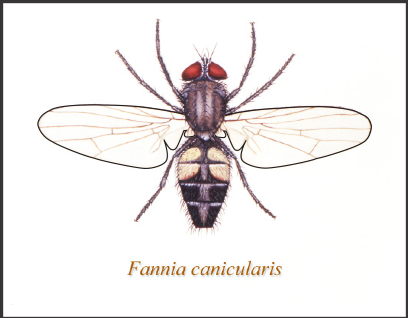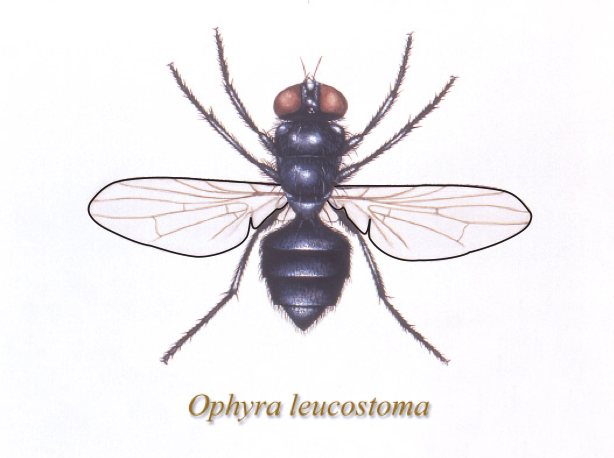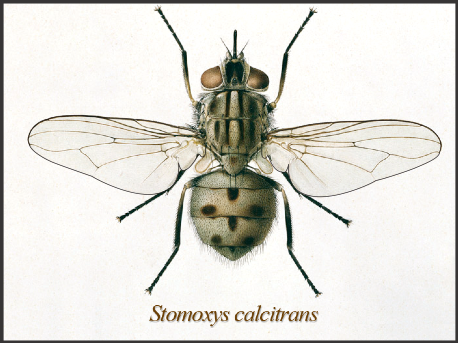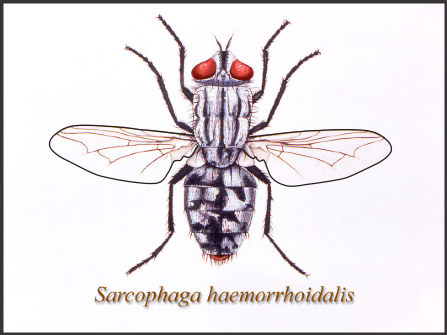Types of flies
Besides the grayish-black house fly, several other kinds of flies are found in the home. Control of these is the same as for the house fly, although the elimination of larval sources varies between species.
Blow Flies

Blow flies are larger than common house flies. Several species are characterized by shiny, metallic colors: black, Phormia; blue, Calliphora; and green or copper, Phaenicia, and blue-green, Chrysomyia. They make a loud droning buzz and will lay eggs on exposed meat ("flyblown flesh").
The larval development of green or copper blow flies, most commonly found in garbage wastes and pet droppings, is completed in less than a week, while that of black or blue blow flies requires 10 to 15 days.
Chrysomyia megacephala, the Oriental latrine fly, showed up in southern California in 1989. Since then, it has spread throughout Orange County and can be a serious pest around trash dumpsters containing rotting meat, animal waste, and used diapers. They are larger and bulkier than other blow flies and often cluster in large numbers in shaded areas during the summer. The life cycle from egg to adult is 8 to 10 days at room temperature.
If a blow fly larval source is in or near a house, mature larvae may migrate away from that source, enter the house under door openings, and crawl under objects such as carpets and furniture to pupate. When they emerge, the adult flies then become an indoor nuisance.
Little House Fly

The little house fly (Fannia cannicularis) characteristically flies to-and-fro in the middle of a room. Seldom landing on human food, it is less apt to contaminate food than the true house fly. Maggots develop from eggs laid in well-decayed vegetable matter, compost, or in animal excrement such as rabbits and poultry. The life cycle requires about 24 days.
False Stable Fly

The false stable fly (Muscina stabulans) is slightly larger and stouter than the common house fly and generally dark gray in appearance. It cannot bite like the true stable fly but may enter houses and lay its eggs on slightly spoiled foods. Maggots are frequently seen in animal excrement and decaying vegetable matter. The life cycle is normally 14 days.
Black Garbage Fly

Black garbage flies (Ophyra species) are small, slender, black, shiny flies about 1/5" long. They develop in great numbers in garbage wastes but are not usually found around homes in large cities. They are abundant around rural premises, particularly those not having routine garbage collection. The life cycle requires about 10 days.
Stable Fly

The stable fly (Stomoxys calcitrans) resembles the house fly but has a slender, pointed beak with which it pierces skin and sucks blood. It is normally an outdoor fly, feeding on domesticated animals, but may enter houses in rainy weather. Although stable flies can deliver a painful, irritating bite to humans, it is more important as a pest and disease vector in livestock and domestic pets. To control stable fly maggots, each week dispose of stable manure, urine-soaked straw, moist spilled feed, and moist decaying vegetation like lawn clippings or decaying seaweed washed up on shores and beaches.
Flesh Fly

Flesh flies (Sarcophaga species) look like overgrown house flies. The more common ones have a checkerboard pattern on the abdomen. They deposit living maggots rather than eggs in spoiled meat, decaying flesh and excrement, especially dog droppings. The flesh fly needs only eight days for the life cycle. Other common sources may include animal carcasses and dead snails.
For more information on flies, please click here.
